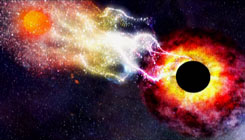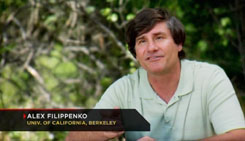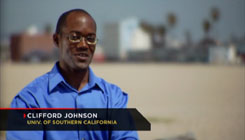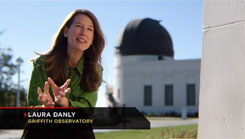The fourth season of "The Universe" comes to its conclusion with
one of its cleaner, more interesting, and more fun episodes here.
Kickstarting this in-depth look at the many inter-related forms of energy
is a segment on its transformation from one form to another. Here, we end up
getting a bit of a buffet, with all the many forms spread out before us,
while the scientists give details about what it is that makes many of these
forms different, and in what ways they are all the same. Einstein's
E=mc� is brought in to give us the idea that matter itself is a form of energy,
yet strangely this sits side by side with the old Newtonian concepts
of kinetic and potential energy, while no one comments on how the calculation
of such things had to be re-thought and overhauled to conform with
relative frames of reference. It would also have been nice to note
that, in E=mc�, the transformation is solely the acts of absorption/emission
between matter and the energy of electromagnetic radiation.
But then, even when some combinations don't sit too well with each other,
this buffet has a bit of everything on offer.
Amy Mainzer:
"Power is equal to energy per unit time."
The next segment focuses on the various forms of energy and
energy transformations involving stars, like our own sun.
Topics include solar flares and charged particles as well
as most of the common big changes that can occur during
a star's life cycle. Curiously though, the segment begins
with Amy Mainzer's demo of an electric sportscar, which
is only cleanly sun-related when your house is also powered
by solar panels. Those of us still on an electricity grid
powered by coal or dirty nuclear fission might still be
putting much pressure on the environment with an electric car.
And the "Ask the Universe" question for this episode is...
"How can we harness energy from neutrinos emitted by the sun?"
- Alan K., Chicago, Illinois
The discussion naturally eases itself from stars and
supernovae to supermassive black holes at the center of galaxies
and some of the even higher energy transformations occurring there,
including some far-fetched concepts for harnessing that energy.
Some of the episode's most startling imagery is featured
at this point. Much time is then spent on discussing
the resulting cosmic rays, and their possible impacts
on our technology.
The fascinating section on the Earth's geothermal energy and
how we harness it nicely expands into a discussion of
similar energies on the giant planets of our solar system
and on Jupiter's moon Io. Winds on these planets and on
Earth are also explained and discussed.
Finally the enigma of proposed dark energy gets its moment
in the spotlight. Though this subject has been tackled
before on "The Universe", and even got its own episode,
the presentation here is actually the clearest, most
watertight explanation of what it is, why we think
it is there, and how it deeply affects the fundamental
cosmology of our entire universe. Laura Danly is really
on form in this segment. Very much worth checking out.
Overall, this is one of the better episodes of the fourth
season, one which tackles a fascinating subject and draws
some classic moments out of the regular scientists and onto film.

|
Participants include:
|
from the disc sleeve:
Extreme Energy:
Ours is a universe of energy, from powerful jets ejected from black holes
to the raw nuclear fury of the Sun. But the total amount of energy in the
universe maintains perfect equilibrium; no more can be added or taken away.
Because of this, there are enormous amounts of energy, from electric to
thermal to kinetic, being transferred and creating awesome cosmic events
and stellar displays.
Chapter List:
- Introduction
- Transformers
- Solar Power
- Supermassive Black Holes
- Geothermal Energy
- Dark Energy
|
|

















